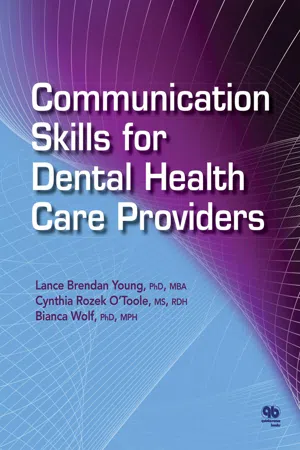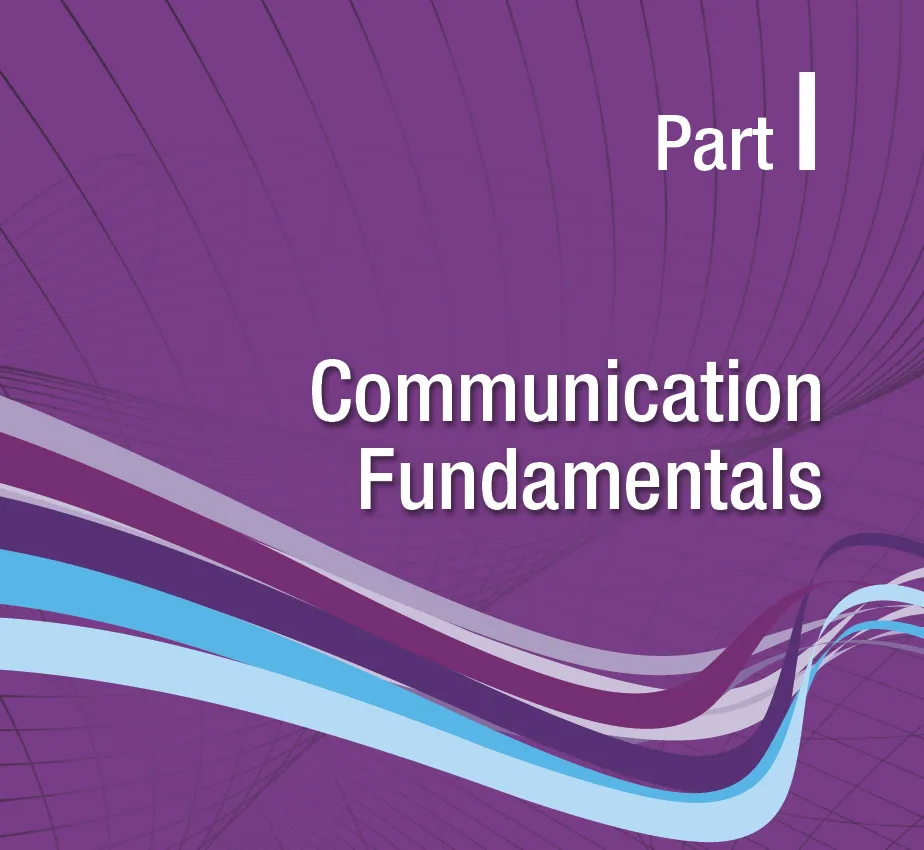
eBook - ePub
Communication Skills for Dental Health Care Providers
- 352 pages
- English
- ePUB (mobile friendly)
- Available on iOS & Android
eBook - ePub
Communication Skills for Dental Health Care Providers
About this book
This evidence-based textbook presents the essential communication strategies clinicians should know to facilitate interaction with patients. With a focus on practical strategies instead of dense communication theories, the authors facilitate improved patient-provider communication and demonstrate how to elicit accurate patient information during the health interview, communicate effectively during examinations and procedures, and present preventive and restorative treatment plans from a patient-centered perspective.
Frequently asked questions
Yes, you can cancel anytime from the Subscription tab in your account settings on the Perlego website. Your subscription will stay active until the end of your current billing period. Learn how to cancel your subscription.
No, books cannot be downloaded as external files, such as PDFs, for use outside of Perlego. However, you can download books within the Perlego app for offline reading on mobile or tablet. Learn more here.
Perlego offers two plans: Essential and Complete
- Essential is ideal for learners and professionals who enjoy exploring a wide range of subjects. Access the Essential Library with 800,000+ trusted titles and best-sellers across business, personal growth, and the humanities. Includes unlimited reading time and Standard Read Aloud voice.
- Complete: Perfect for advanced learners and researchers needing full, unrestricted access. Unlock 1.4M+ books across hundreds of subjects, including academic and specialized titles. The Complete Plan also includes advanced features like Premium Read Aloud and Research Assistant.
We are an online textbook subscription service, where you can get access to an entire online library for less than the price of a single book per month. With over 1 million books across 1000+ topics, we’ve got you covered! Learn more here.
Look out for the read-aloud symbol on your next book to see if you can listen to it. The read-aloud tool reads text aloud for you, highlighting the text as it is being read. You can pause it, speed it up and slow it down. Learn more here.
Yes! You can use the Perlego app on both iOS or Android devices to read anytime, anywhere — even offline. Perfect for commutes or when you’re on the go.
Please note we cannot support devices running on iOS 13 and Android 7 or earlier. Learn more about using the app.
Please note we cannot support devices running on iOS 13 and Android 7 or earlier. Learn more about using the app.
Yes, you can access Communication Skills for Dental Health Care Providers by Lance Brendan Young,Cynthia Rozek O'Toole,Bianca Wolf in PDF and/or ePUB format, as well as other popular books in Medicine & Dentistry. We have over one million books available in our catalogue for you to explore.
Information

This first section introduces key concepts that are fundamental to effective chairside communication with patients. Individuals who develop communication skills without first understanding communication or their audience may express themselves in a way that sounds insincere or even aggressive. Effective communicators understand how communication functions and can anticipate how it might function with a specific patient in context. This section provides an overview of health communication and its importance to patient-centered care (chapter 1), describes patients’ perceptions of dentistry (chapter 2), and discusses cultural influences that shape patients’ communication patterns (chapter 3).
1
Understanding Communication
Why Communication Matters
This initial chapter provides a rationale for studying patient-provider communication. However, this manual is focused on skill acquisition, so we feel it is best to present the rationale as a competence to master instead of simply listing the reasons why you should read our book. The rationale-as-skill concept becomes clearer to us the longer we teach dental students. Let us explain.
When people ask what we do, we reply that we teach patient-provider communication skills to future dentists. Usually, the responses fall into one of two categories. Some people are completely baffled and ask to know what we mean. Others make a lame attempt at humor: “It should be pretty easy to communicate with dental patients because they can’t talk back!” We have heard many variations of this theme and try to smile every time.
In truth, the fact that dental patients are often restricted in their verbal expression makes instruction in communication more important, not less so. Communication is far more than rattling off the latest sports scores while manipulating dental instruments in a patient’s mouth. The quality of patient-provider communication determines a wide range of outcomes, including satisfaction, treatment adherence, information comprehension and recall, and ultimately oral health.1 For this reason, we have developed a skill of explaining and illustrating the importance of effective communication with dental patients. Those who work in a dental office—as a dentist, hygienist, assistant, or receptionist—should master this skill so that all of the practice’s employees will better understand the value of effective patient communication.
The fundamental communication lesson professionals must learn is that they cannot assume that everyone understands a message in the same way. To apply this lesson to the task at hand, we will explain and explore four key concepts: (1) communication, (2) health communication, (3) patient-provider communication, and (4) patient-provider communication in dentistry. For each concept, we will define the key term and analyze its implications and associated goals.
What Communication Is
Definition of communication
People from varying disciplines have defined communication in vastly different ways, from the mechanical definition that relates communication to audiology and broadcast transmission, to the philosophic definition that ties it to ontology and epistemology.2,3 Between mechanics and philosophy is a social science discipline, which acknowledges both the concrete realities of message transmission and the varied ways humans interpret the meaning of messages. A good working definition has been provided by Stoner et al4: “Communication can be defined as the process by which people share ideas, experiences, knowledge and feelings through the transmission of symbolic messages.” Four aspects of this definition are particularly important for dental professionals to keep in mind: (1) communication is a process, (2) communication is multifunctional, (3) communication is multichanneled, and (4) communication is not always intentional.
Communication is a process
Often, communication is understood as individual expression. However, when people view communication as a singular act of self-expression, they risk treating other individuals as mere witnesses or audience members, rather than people with whom they are building a relationship. The working definition on page 4 clarifies that communication occurs only when two or more people are mutually involved in a process of sharing. Dental professionals must remember that effective communicators cannot rely on a script to build relationships.
Communication is multifunctional
The messages shared when providers and patients communicate perform many functions, often simultaneously5 (Table 1-1). Because communication is a process, achieving those functions depends on both the way a message is sent and the way it is received. Dental professionals must remain aware of their communication goals and listen to patients for indications that the goals are being achieved.
Table 1-1 Functions of communication
Function | Example |
Psychologic | Establishing your professional role in patient introductions |
Social | Cultivating patient trust through conversation |
Informational | Explaining to patients the condition of their oral health |
Influential | Urging patients to stop smoking |
Communication is multichanneled
Too often, people think that communication is synonymous with speech, but messages are transmitted through multiple channels, both verbal (speech and writing) and nonverbal (appearance, gesture, and facial expression, among others). Those channels usually operate simultaneously. Dental professionals must remember that some channels are better suited to certain messages than others and that messages sent through one channel should not contradict messages sent through another.
Communication is not always intentional
Another misconception is that communication is restricted to messages we intend to send. While it is true that intentional communication is valuable, any behavior can transmit a message, regardless of intent. Even complete passivity—the refusal to act—communicates, leading some to argue that humans cannot help but communicate. Further, the definition suggested by Stoner et al4 acknowledges that we communicate with others through symbols (such as words or gestures), and symbolic messages are effective only insofar as they hold similar meaning for both sender and receiver. This is perhaps the hardest lesson: Dental professionals are constantly communicating, and they have limited control over how messages are received. However, the chance that patients will receive the intended message can be improved if dentists enhance their skills of expression and pa...
Table of contents
- Cover
- Half Title Page
- Title Page
- Copyright Page
- Contents
- Preface
- About the Authors
- Part I Communication Fundamentals
- Part II Interaction Skills
- Part III Communication During the Appointment
- Part IV Communication Challenges